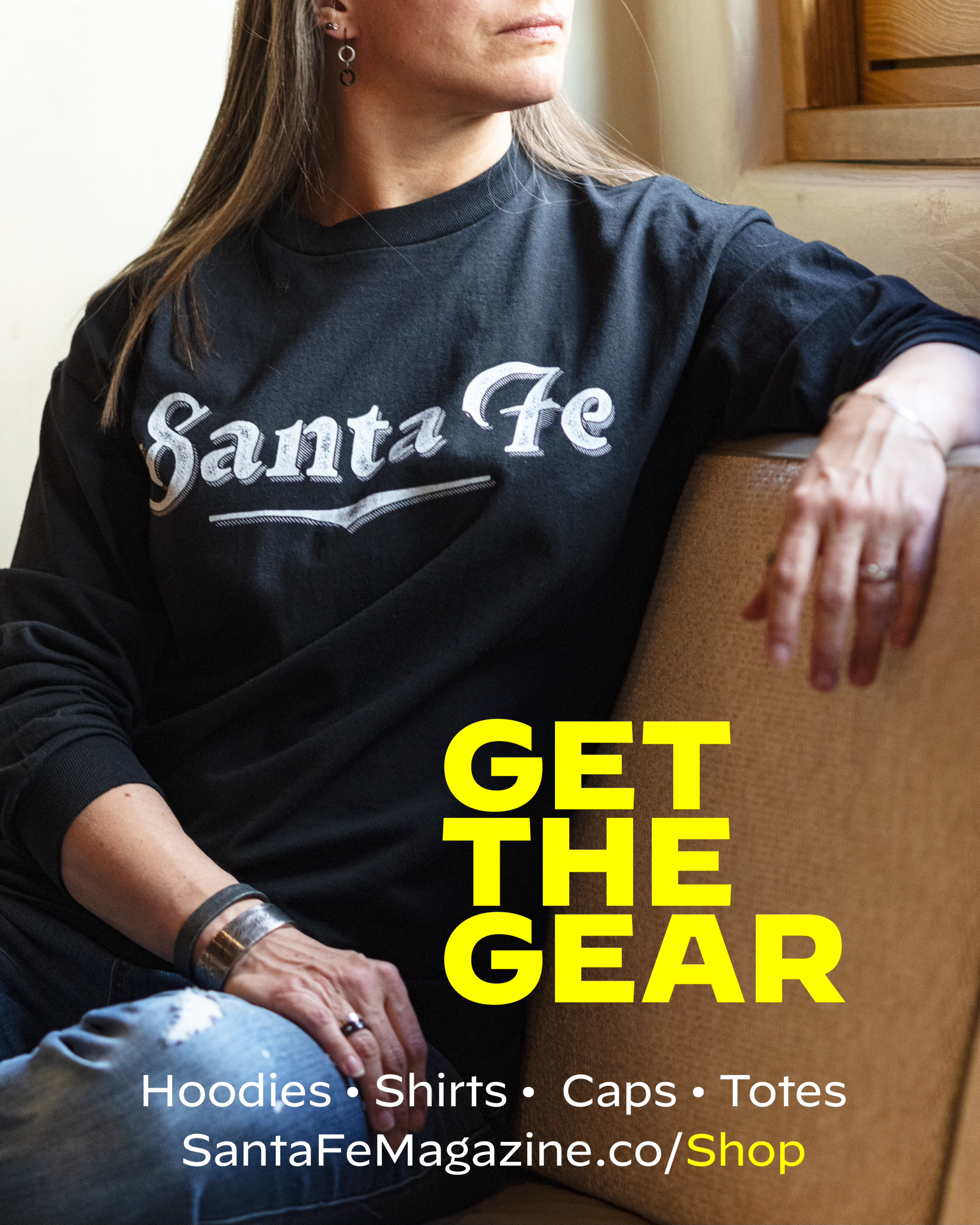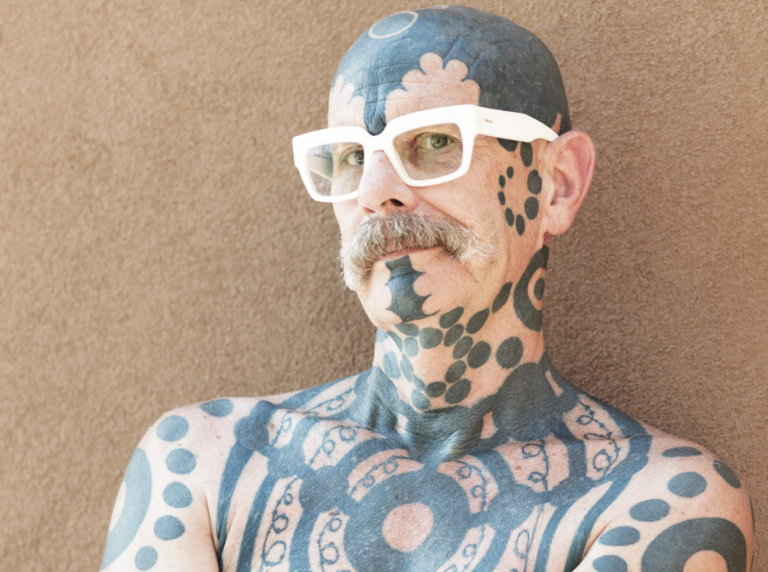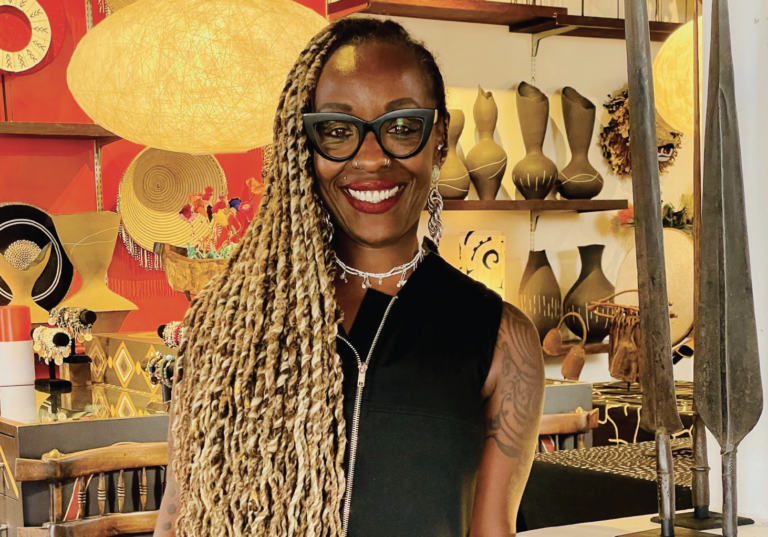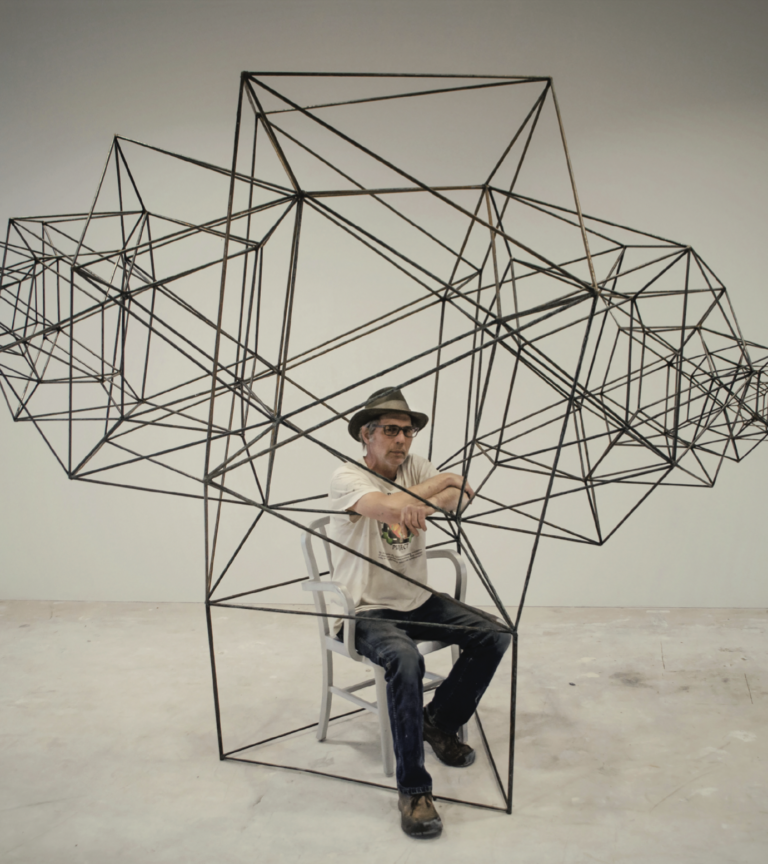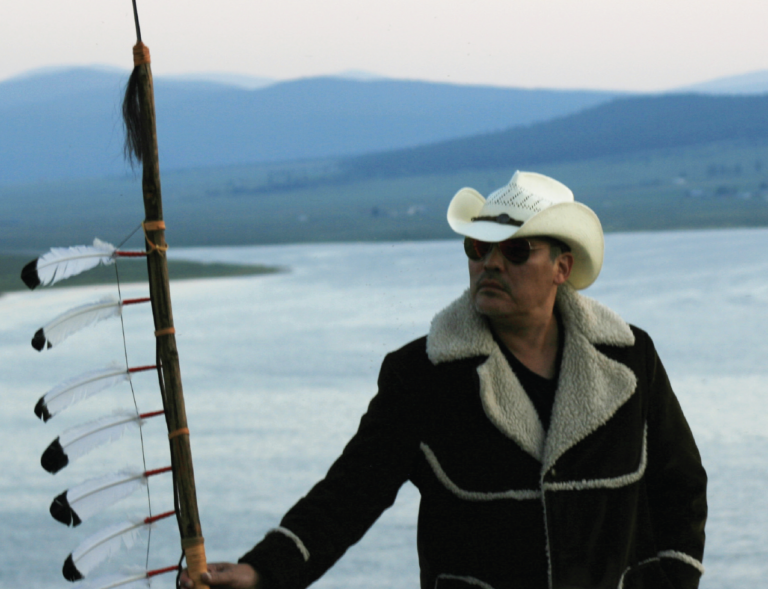I MET TOM FARRIS DUCKING OUT OF HIS TRUCK. He’d been driving with his family through a monsoon and had just landed at the Santa Fe Convention Center for Indian Market.
We sat down for a drink. Immediately, he was eloquent, powerful, and hilarious.
Tom didn’t start his art until he was 30. “Didn’t have very much to say,” he explains.
He has a lot to say now, and it all takes the form of a riff on what he calls “the dominant American culture.” The theme is at once subversive, cool, and true: The general public education about Native Americans is basically the Trail of Tears.
Warhol-like, he takes pop icons and gives them what he calls a “Native touch.” For example, he takes the Batman logo and translates it into Cherokee. Hot Wheels become Rez Wheels. And he rebuilds a slot machine with a revisionist theme of Manifest Destiny: Settle the country by any means necessary, subjugate seven generations, and win big. The coins for the slot machine are alcohol, a diseased blanket, treaties, etc.
Tom is an original. I’d bet on him…big.
You started painting at 30.
I didn’t have anything to say when I was a kid. But comic books are a huge influence in my life. What does that say? For me, if you’re making art, you want it to say something or teach a lesson or start a conversation. That’s why everything I do is just…I want people to see it and say, Oh, I never thought of it that way.
I’ve always liked art. I started collecting when I was 16, and my parents were collectors even before I was born. The thing I like about what I do is that I’m not a full-time artist, so I can kind of make whatever I want to because I’m not necessarily worried if someone’s gonna buy it. I wanna make what I want to make.
I just saw an opportunity to utilize art to actually do something – to introduce all these ideas that I knew about but were never taught in school. When you grow up Native, you know all these things because that’s your history and what your family has grown up with. But it’s not taught to you in school. What people learn in general public education about Native Americans is basically the Trail of Tears, and that’s about it.
So I take pop iconography and give it a Native perspective. I take images that the general population is comfortable with and then add a little bit of subversion, some Native culture. I took the 1966 Batman logo and translated that into Cherokee. Batman in Cherokee.
That’s so interesting.
Yeah, it’s Shlamiha asgaya. I loved the 1966 Batman. Like, Adam West is my Batman. I love him.
Basically, what I’m doing is kind of giving people a peek into my mind: Okay, yeah, I love 1966 Batman. Everybody else does too, but hey, isn’t this cool that Cherokees have our own written language? This is what it would look like in Cherokee. That justifies my piece – the fact that Cherokees speak Cherokee and have a written language. Most people don’t know that.
If you’re dealing with heavy subjects like boarding schools and genocide, if you’re yelling at people, they turn off from that. But if you can talk about Batman…if you can make a joke, make someone laugh, and then slide in a little bit of message, people are more receptive.
I won the Innovation Award at the 2019 Indian Market for a piece I did: a slot machine that I took apart and rebuilt. I redid all the artwork in it, and the machine’s theme is “Manifest Destiny.” The message is Settle the country by any means necessary, subjugate seven generations, and win big. That’s what the machine says. And on the reels, each one of those items is something that was used to take land from Native people. So there was alcohol and diseased blankets, religion, treaties, all these things…
They’re all examples of how the land was taken from Native people. But the machine itself is how Native people are buying their land back – through tribal gaming. They’re reestablishing themselves as an economic powerhouse.
So you’ve been doing this for 13 years?
Yeah. And I’ve been showing here for about 10 years.
I’m a big fan of ledger art. Ledger art is based on historic ledger drawings that were used during removal of Natives. And Native people got their hands on that ledger paper. They would depict historical moments in their history – battles, that kind of thing. And now there are contemporary artists that are using those as inspiration to create a new version, all on this historic paper. I have a ledger from 1926 that I use pretty often. It’s just a real big book, and I’ve got a lot of paper. But in the future, everything’s paperless, so what are ledger artists gonna do?
I took decommissioned hard drives, made that the contemporary ledger, and painted imagery on that. Then I started doing what I considered to be the contemporary historical moments for Native people today. So I did one about when the Washington Redskins got rid of their name. I did one for all the Columbus statues coming down. I have this idea that these are gonna be the historical moments of today, so why not capture them on the ledger of today?
I hear you’re big on vintage Pontiac Catalinas?
My favorite is the ’53. What I loved about those is that art deco style of Native imagery. The thing that frustrates me is that most people don’t realize that Pontiac was a real person.
I always saw those hood ornaments and thought, Man, that would fit perfectly on the back of a ball-headed war club. So that’s what I did: I took that co-opted Native image and put it on a Native object – brought it full circle, reclaimed the imagery.
Do you take offense at the sort of depraved versions of your history?
I just want people to know what we, as Native people, know. There’s all this uproar about critical race theory, which is really just a fancy way of saying telling the truth in history. That’s all it is. It is critical because the dominant culture hasn’t always been the best servant of their people. I’ve become accustomed to the dominant culture not being terribly in touch with the truth.
Native culture has been so misrepresented in pop culture.
It makes sense that people have misconceptions. But that doesn’t make it any less incorrect. When I was a kid, I played with the little plastic Indians, and in that toy set, there’s a tepee and a totem pole. Why? Those things could not be from two more different cultures – it’s like putting a traditional object from Japan with one from Ireland.
That’s Northwestern culture and Plains culture. Those would never be together. That’s Western Pan-Indianism.
What are the most irritating misconceptions?
One the things that isn’t as prevalent or widely known about Native people is their humor. When people see my work, they’re like, Oh, your work is so funny – I would never expect that. And I’m like, Well, you don’t hang out with many Native people, then, because I’m not even that funny compared to the people I know.
And there’s the lack of contemporary representation; even though it’s 2022, people ask, Do you still live in tepees? Do you ride horses?
Oh, and there are always people saying to me, You know, I’m actually Indian, but I just can’t prove it. So it’s like, okay, even if you could prove it, you’re not Native culturally, so why does it matter to you? If, all of a sudden, you could prove that you’re Native, how would that change you as a person?
I did a piece called “What’s in Your Wallet?” Native people still have Certificate Degree of Indian Blood (CDIB) cards. It’s how you prove that you’re Indian. I actually just got mine upgraded on my Cherokee side.
Do you carry one?
I had to carry one to get into Indian Market. Interesting that no other ethnicity has to prove they are who they are.
We’ve always been forced to acclimate or to fit in. We were robbed of our culture. The US government didn’t want to learn how to live with Native people – they called it termination. Natives were supposed to be quiet and be American. We weren’t allowed to speak our languages, and they took our kids from us, put them in boarding schools, and literally beat it out of them.
I have the letter that was sent to my grandmother’s parents, saying, Your child has been identified as in need of education. She was taken from her parents and put in a boarding school. She wasn’t allowed to speak Cherokee or wear anything traditional. She had to wear Western clothes.
The stated course of boarding schools was to kill the Indian, save the man.
Oddly enough, that was the one good thing that Nixon did – he ended termination.
You know, until my mom passed away in 2016, I didn’t realize that her maiden name is actually not her maiden name. What happened is that when children got allotment land, families would illegally adopt the Native children for their land.
The most hostile thing you can do is rename somebody. Change someone’s name, and you take their identity. So my name is Tom Farris, but my middle name is Chadonahe. That’s an Otoe-Missouria name. It was my great-great-great-grandfather’s name; it means standing buffalo, and that is what my parents call me to this day.
It’s an assertion of ownership, in the same way that people don’t understand why Native people have such an issue with Redskins. They’re like, It doesn’t mean anything. And I’m like, No, it really does.
That word comes from the precise ad that said, We’ll pay you $200 for every Redskin you bring, which is worth more than every soul in hell, every Indian soul in hell. Basically, they were saying, It’s not even worth $200, but that’s what we’re gonna pay you. And that’s kinda fucked up.
Learn more at theartoftomfarris.com
Photo SFM


